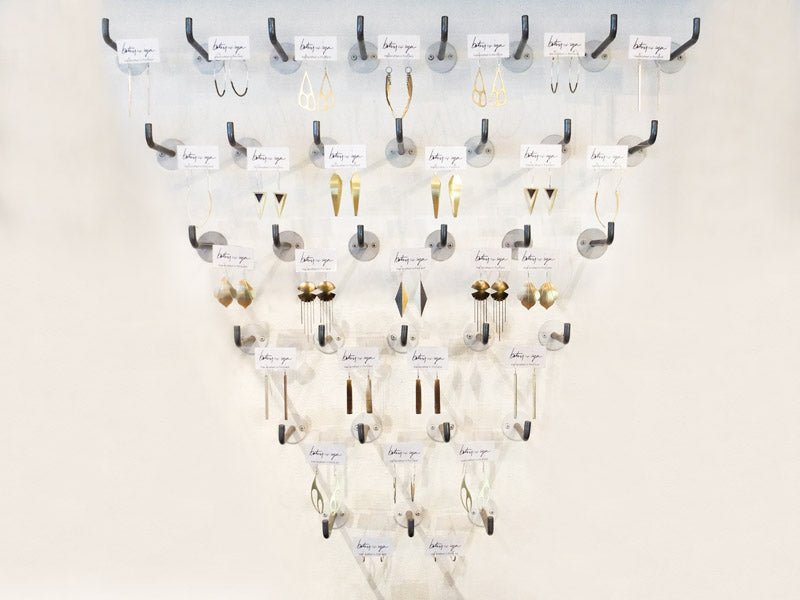
14k gold - We know we love 14 karat gold, but why? Well, pure, 100% gold is 24 karats. However, pure gold is soft. 14 karat gold means that 14/24 parts of the piece are pure gold. This balance makes it much more durable than pure gold - more durable than 18k, 20k, and 22k gold as well. It’s less likely to break, bend, or scratch, so it’s much safer as a beloved ring.
Conflict-free diamonds - All of our diamonds are sourced from suppliers who adhere to the Kimberley Process, which is an international certification scheme that regulates trade in conflict diamonds. Conflict diamonds are rough diamonds that are used by rebel movements to fund armed conflicts meant to overthrow legitimate governments. The Kimberley Process’ site really has all the information you’ll ever need, but basically our diamonds are guaranteed to have no part in overseas conflict. Ethical!

Baguette-cut diamond - Whether the name “baguette” comes from the stone’s resemblance to the long, delicious type of bread or from the diminutive of the French word “bague” (ring), we can all agree this stone cut is pretty great. Baguette-cut diamonds are long and rectangular, with step cuts, or parallel facets that are arranged neatly on top of each other, like little terraces. Baguette-cut diamonds usually have 14 facets, so they’ll be super reflective and sparkly. That’s fine by us!
Step-cut tapered baguette - This is a combination of a step-cut (parallel facets on the stone) and baguette-cut (long and rectangular) diamond. A tapered baguette-cut diamond has the long sides of the diamond tapering inwards to give it a unique shape.

Brilliant-cut diamond - Brilliance on its own refers to the light that’s reflected from the inside of the gem (not reflected from the surface). The precisely cut facets and clarity of the gem contribute to the brilliance of the stone, so a brilliant-cut diamond has been cut in a particular form to have maximum brilliance. The color of the stone will be super clear and gorgeous, and light that enters it will bounce from facet to facet perfectly.
Black diamond - Diamonds come in all different colors (think green, pink, red, yellow), not just varying shades of clarity. Black diamonds are just another color! The black color comes from dark inclusions, usually graphite. It’s possible that black diamonds came from meteorites that fell to Earth - amazing, right?
Yellow gold - All betsy & iya fine rings are pictured yellow gold, which is actually an alloy (a metal made up of two or more other metallic elements). We already know this because we know that 14k gold isn’t pure gold. Different alloy combinations - like gold & copper, gold & nickel, gold & palladium - give us different colors of gold (like rose gold or white gold), all with their own benefits.
PS: did you know that customers can request a metal other than yellow gold? You can get rose gold, white gold, platinum… It’s your choice!

Stone settings
Flush setting - In this setting style, the diamond is set “flush” with the surface of the metal. This means that the top of the diamond will be just about on the same level as the metal.
Prong setting - Prongs are designed to sort of act like a claw, holding a stone in place in a visually unobtrusive way. The prongs in our Spero ring are super unobtrusive - they’re such a beautiful part of the ring that you probably won’t even be able to tell where they are! Proof that functionality and beauty are truly an ideal combination.

The Four C’s - If you’ve been shopping around for some fine jewelry, you may have come across some mention of the Four C’s. These are the four most important characteristics of a diamond to know about when buying, and we’ll break down what each C stands for!
Clarity - No diamond is perfect. Some come reeeeeally close, but most have unique marks (known as inclusions or blemishes), due to being formed under a lot of pressure. The clarity of a diamond refers to the absence of such marks and is measured on a scale with 11 grades. Most diamonds are either VS (very slightly included) or SI (slightly included), which still means the inclusions are only noticeable to a skilled diamond grader under 10x magnification!
Inside tip: If you want even more info on clarity grading and a neat little interactive slider with examples of each grade, check out GIA!
Color - Diamonds - white diamonds, that is - are valued by how close they are to being colorless. They’re graded on a scale from D-Z, with D being colorless and Z yellow or light brown. Diamonds are graded for color very precisely, as each letter has a very defined range of color.
Cut - The cut of a diamond is immensely important. We know the brilliance of a stone (light reflected inside the stone) depends on the cut quality, but the stone’s visual enticing-ness pretty much depends on it as well. There are 7 components taken into consideration when grading a diamond’s cut, which then gives a grade from Excellent to Poor.

Take a look at this image (from GIA). Who knew the terms “girdle” and “pavilion” could apply to diamonds? You can imagine that all of these facets and angles in the diamond impact each other in different ways, so the cut grades measure proportions to see how well a diamond has been cut. A well-proportioned diamond will have the maximum amount of light reflected back out of the crown (top) of the diamond. (That’s brilliance!)
Carat - Don’t confuse this with KARAT! Carat refers to gemstone weight, Karat refers to gold purity. 1 carat = .2 grams, but carats don’t determine value entirely. Everything else we’ve gone over affects the stone’s value and most diamonds in fine jewelry are 1 carat or less. Like everything else in the 4 C’s, carats are measured with great care, often measured to the hundred-thousandths of a carat. (1.00001 is one and one one-hundred-thousandth!) They’re then rounded, but still - that’s a lot of precision.

Hand carved - Once Betsy finalized her designs for the fine collection, she then carved molds for them out of wax. She used intricate tools to ensure that the model looked exactly like the finished ring she envisioned. Once the wax model is perfect, the casting process begins. Hand carving the molds only happens once, whereas the casting process happens frequently.
Lost-wax casting - Lost-wax casting is a process where the molten metal is poured into a mold, which then melts away (‘cause it’s wax), leaving the metal to take its shape. The molds are made from the original wax carvings Betsy made, which is why she only has to carve once! This way, you know exactly what you’re getting with our fine jewelry collection. The diamonds need to be secure and we want your precious piece to turn out exactly the way it should. (Um, have you seen our video on the casting process?? Pretty cool.)
Matte finish v. polished finish - Our fine collection comes in two finishes. For a polished finish, we use special compounds to get the ring to a nice glossy high-polish. A different surface treatment gives the ring a matte finish, which can be a cool alternative to the shinier polished finish.
Half moon - Another name for this stone cut is demilune, which isn’t important for any other reason except I think it’s a beautiful name. Half moon diamonds can be used as side stones with rectangular or oval stones, or, as you can see in our Omnia ring, are stunning as the focal piece. And, as a bonus, our Omnia rings stack perfectly with our Cor rings! Go half moon diamonds!
Hopefully, this list helps you understand more fully what goes into making a fine ring, and what to look for when buying your own! We love how much effort goes into picking the perfect ring and want to be by your side the whole time.



